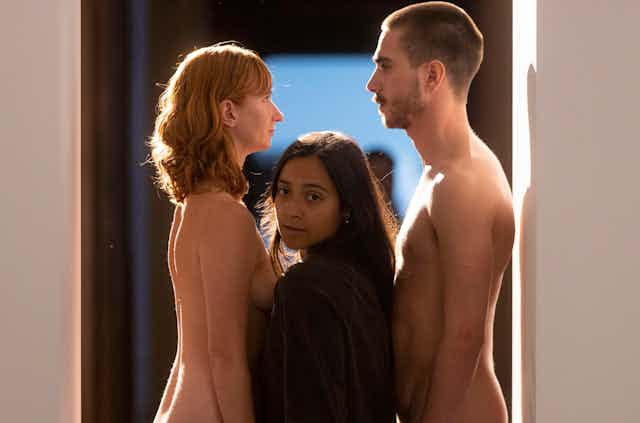In 1974, Marina Abramović performed a career-defining work at a small experimental gallery in Naples, Italy. The Serbian artist stood naked next to a table on which she had arranged 72 objects associated with pleasure and pain. They included a bunch of grapes, a jar of honey, a feather, a whip, chains, a scalpel and a gun.
Accompanying text instructed the audience: “There are 72 objects on the table that one can use on me as desired. I am the object.” The performance, entitled Rhythm 0, lasted for six hours, during which Abramović was tickled, cut, written on and chained. Everything was documented by photographers, whose presence she had arranged. When someone held the (allegedly loaded) gun to the artist’s neck, the performance ended.
Half a century later, Abramović is the celebrated grand dame of live, performance, or body art. In this avant garde practice, the artist’s body takes the place of the object as the means of expression. She is also the first woman in the Royal Academy of Arts’ history to have a solo retrospective in its main galleries.
On entering Abramović’s retrospective, I was instructed not to photograph the performers. I hadn’t planned to take pictures, but this request struck me as strange. Photographic documentation is as integral to performance art as a wall is to a Renaissance fresco, or an acoustic echo is to a choral mass.
Everything I already knew about Abramović’s work was based on photographs. If photography was now forbidden – and the reenactment of works like Rhythm 0 was presumably ruled out by high levels of risk – what did this say about the changed, or changing, condition of performance art?
The exhibition begins not with live reenactment, but with extensive recordings of The Artist is Present, a performance first staged at New York’s Museum of Modern Art in 2010. Abramović invited audience members to sit opposite her at a table and to stare into her eyes for as long as they wanted while the procedure was filmed.
From here, the exhibition moves roughly chronologically through Abramović’s career. Rhythm 0 appears next, represented by the unsettling arrangement of threatening and seductive objects and a looping slideshow of the original 1974 performance.
Adjacent to this are black-and-white photos of a performance in which Abramović prostrates herself inside the flaming five-pointed communist star. And a large format colour picture of her 1997 Venice Biennale performance of Balkan Baroque, where for days on end she scrubbed blood and sinew from a pile of grisly cow bones.
From 1976 to 1988, Abramović collaborated with her lover, the Dutch artist Ulay. The RA show presents slides and videos of the works they made together that explored relationship trust dynamics. The best of these crystalise the tensions and vulnerabilities of intimacy into strikingly memorable image sequences, such as Rest Energy (1980), in which Ulay holds an arrow pointing directly at Abramović’s heart.
The limits of re-staging
Accessing the next gallery involves negotiating the narrow space between a man and a woman, both naked. They are avatars for Ulay and Abramović in the 1977 performance Imponderbilia. The work has been re-staged to neutralise its impact, so that instead of being compelled to enter the personal space of the blank-faced performers, visitors can take an alternative route that avoids them.
Intending to photograph the silhouetted profiles the pair cast on the floor, I reached for my phone, only to be admonished by a security guard. They explained that not photographing performers also meant not photographing their shadows.

This absurd interaction reinforced the limits of re-staged performance art. The point reasserted itself with the re-staged work Nude with Skeleton. As I stepped closer to discover whether Abramović’s double was a live performer, a waxwork, or some kind of deepfake, another guard stepped purposefully into my line of vision, repeating the move when I sidestepped to look around them.
Throughout this substantial exhibition, Abramović’s desire to commune with her audience is stressed. But in practice, this intention is undermined by protocols of performer protection which distort the conditions of immediacy on which these works originally relied.
Transitory objects
When the audience is allowed to engage, their experience is mediated through a series of what Abramović calls “transitory objects”. These are made from materials associated with healing that you might expect to encounter in a wellness spa: crystals, green onyx, chamomile flowers.
Abramović claims these objects induce feelings of transcendence when they are stepped into, lain on or leaned upon. The objects are theatrically lit so that anyone interacting with them becomes part of the exhibition spectacle.

As I lay on a copper bed with my head awkwardly resting on a green onyx pillow, I prayed – not for transcendence, but that no one would sneakily take my picture and post it on social media. From this uncomfortable 21st-century position, I contemplated the possibility that the traumatic fallout of being threatened in 1974 by an audience member with a loaded gun had defined the subsequent course of Abramović’s work.
Despite this exhibition’s emphasis on care, transcendence and participation, Abramović’s work is defined by the apparent need to control her audience’s experiences while celebrating her own. It makes sense then that she has consistently distanced herself from the collective efforts of feminism. It also seems fitting that with her individualistic narrative, Abramović is the first women artist to have a solo exhibition at an institution that – for the past three and half centuries – has reserved this honour only for men.

Looking for something good? Cut through the noise with a carefully curated selection of the latest releases, live events and exhibitions, straight to your inbox every fortnight, on Fridays. Sign up here.

